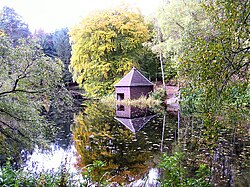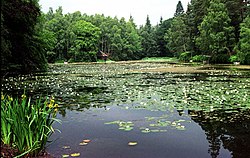Faskally Forest
| Faskally Forest | |
|---|---|
 Faskally Forest around Loch Dunmore | |
 | |
| Type | Mixed woods |
| Location | Perth and Kinross, Scotland |
| Coordinates | 56°42′N 3°45′W / 56.7°N 3.75°W |
| Area | 25 acres (10 ha) |
| Created | 1953 |
| Operated by | The Forestry Commission |
| Open | All year |
Faskally Forest, also known as Faskally Woods, is a wooded area in the historic county of Perthshire, Scotland.[1] It is among the mixed woodlands of Perthshire, and is well known for its radiant colours during the autumn. It is one of the early forest lands of Perthshire Big Tree County.[2] Originally a "model woodland" developed in the 19th century with a resort owned by Archibald Edward Butter.[3][4] In 1953, Faskally was acquired by the Forestry Commission of Scotland to set up a school for training young foresters.[4]
A colourful annual event at Faskally, known as "The Enchanted Forest", received awards consecutively for three years (2011–2013), as the Best Cultural Event in Scotland.[5]
Location
Faskally Woods is located about 1 mile (1.6 km) north-west of Pitlochry, which is also a railhead.[4]
It is situated on Loch Faskally's north shore, while the forest itself contains Loch Dunmore.[6] When acquired by the Forestry Commission in 1953, it covered an area of about 55 hectares (140 acres), but in the present day measures 25 hectares (62 acres) after undergoing a "transformation into an irregular structure".[1] The Faskally House is situated within this forest.[7] The River Garry flows below the lawns of this house.[3][8]
History
The Faskally Forest was created in the 19th century by Archibald Butter, who later built his estate here. The entire estate was acquired by the Forestry Commission, and Faskally House was used as a forestry training centre until the late 1960s when it was shut down. The forest is maintained on a "continuous cover forestry basis" by developing appropriate management plans.[3][7][9] Faskally Wood became a part of the Forestry Commission's Tummel Forest administration. Under the East Scotland Conservancy, the priority emphasis for its development was to make it a recreation centre with landscaping of high aesthetics, rather than producing timber.[10]
Features

The soil formation in this forest land is a mixture of brown earth and ironpans that are formed above the Dalradian mica schist. In view of sheltered conditions, the area experiences frost. The mean annual rainfall here is about 900 millimetres (35 in).[1]
The vegetation in the early part of the 20th century consisted of European beech (Fagus sylvatica), Douglas-fir (Pseudotsuga menziesii), European larch (Larix decidua), Norway spruce (Picea abies), and Scots pine (Pinus sylvestris). Following the purchase of the forest land by the Forestry Commission, it was subjected to restrictions and restructuring of the forest vegetation, and reduction of the area. Sequential planting occurred, including Douglas fir, Norway spruce, western hemlock (Tsuga heterophylla), European beech, Scots pine, European larch and silver birch (Betula pendula Roth).[1]
As of 1995, Faskally Woods has 23 species of trees comprising an assemblage of "conifers and broad leaves" vegetation such as Douglas fir, silver firs, wild cherry, and oak. The trees are of various sizes, and some are more than 100 years old.[10]
Events
There is a free, weekly 5K parkrun on Saturdays at 9:30am.[11]
Climate
| Climate data for Faskally: 94 m (308 ft) 1991–2020 normals, extremes 1960–2019 | |||||||||||||
|---|---|---|---|---|---|---|---|---|---|---|---|---|---|
| Month | Jan | Feb | Mar | Apr | May | Jun | Jul | Aug | Sep | Oct | Nov | Dec | Year |
| Record high °C (°F) | 14.5 (58.1) |
14.6 (58.3) |
21.6 (70.9) |
23.5 (74.3) |
26.0 (78.8) |
31.2 (88.2) |
30.0 (86.0) |
28.7 (83.7) |
26.8 (80.2) |
21.8 (71.2) |
18.6 (65.5) |
15.9 (60.6) |
31.2 (88.2) |
| Mean daily maximum °C (°F) | 5.6 (42.1) |
6.7 (44.1) |
9.2 (48.6) |
11.9 (53.4) |
15.3 (59.5) |
17.5 (63.5) |
19.2 (66.6) |
18.7 (65.7) |
16.1 (61.0) |
11.8 (53.2) |
8.4 (47.1) |
5.7 (42.3) |
12.3 (54.1) |
| Daily mean °C (°F) | 2.4 (36.3) |
3.2 (37.8) |
5.1 (41.2) |
7.4 (45.3) |
10.2 (50.4) |
13.0 (55.4) |
14.7 (58.5) |
14.2 (57.6) |
12.0 (53.6) |
8.2 (46.8) |
5.1 (41.2) |
2.4 (36.3) |
8.3 (46.9) |
| Mean daily minimum °C (°F) | −0.7 (30.7) |
−0.3 (31.5) |
0.9 (33.6) |
2.9 (37.2) |
5.1 (41.2) |
8.4 (47.1) |
10.2 (50.4) |
9.7 (49.5) |
7.8 (46.0) |
4.6 (40.3) |
1.8 (35.2) |
−1.0 (30.2) |
4.1 (39.4) |
| Record low °C (°F) | −19.6 (−3.3) |
−13.3 (8.1) |
−13.9 (7.0) |
−7.2 (19.0) |
−3.9 (25.0) |
−1.2 (29.8) |
−1.5 (29.3) |
−0.6 (30.9) |
−2.5 (27.5) |
−5.7 (21.7) |
−12.6 (9.3) |
−18.2 (−0.8) |
−19.6 (−3.3) |
| Average precipitation mm (inches) | 120.2 (4.73) |
81.6 (3.21) |
66.8 (2.63) |
56.8 (2.24) |
60.2 (2.37) |
64.4 (2.54) |
75.3 (2.96) |
81.1 (3.19) |
73.0 (2.87) |
107.0 (4.21) |
103.2 (4.06) |
108.6 (4.28) |
998.2 (39.29) |
| Average precipitation days | 16.0 | 13.4 | 12.5 | 10.8 | 10.8 | 11.9 | 13.1 | 12.2 | 11.9 | 15.0 | 15.3 | 14.8 | 157.7 |
| Source 1: Météo Climat[12] | |||||||||||||
| Source 2: KNMI (extremes)[13] | |||||||||||||
References
Citations
- ^ a b c d Cameron, Andrew D.; Hands, Michael O. R. (5 May 2010). "Developing a Sustainable Irregular Structure: An Evaluation of Three Inventories at 6-year Intervals in an Irregular Mixed-species Stand in Scotland". Forestry: An International Journal of Forest Research. Archived from the original on 16 November 2015. Retrieved 2 October 2015.
- ^ Kavanagh 2006, p. 460.
- ^ a b c An Account of the Principal Pleasure Tours in Scotland: With a Copious Itinerary of the Great Lines of the Road ... Thomson. 1821. pp. 1–.
- ^ a b c "Enchanting Woodland on Pitlochry's Doorstep". Forestry Commission Scotland. Retrieved 2 October 2015.
- ^ "The Enchanted Forest 2015". Enchanted Forest Organization. Retrieved 2 October 2015.
- ^ "A Circuit of Loch Dunmore". VisitScotland, Scotland's National Tourism Organisation. Archived from the original on 5 October 2015. Retrieved 5 October 2015.
- ^ a b Irish Forestry: Journal of the Society of Irish Forestors. 1999. p. 79.
- ^ Carleton 1859, p. 256.
- ^ Edlin 1969, p. 44.
- ^ a b Hart 1995, p. 30.
- ^ "home | Faskally Forest parkrun | Faskally Forest parkrun". www.parkrun.org.uk. Retrieved 30 July 2021.
- ^ "United Kingdom climate normals 1991-2020". Météo Climat. Retrieved 25 April 2024.
- ^ "KNMI - Faskally minimum temperature time series". KNMI. Retrieved 25 April 2024.
Bibliography
- Carleton, John William (1859). The Sporting review, ed. by 'Craven'. Oxford University. p. 256.
- Edlin, Herbert Leeson (1969). Forests of central and southern Scotland. H.M.S.O. ISBN 9780114902476.
- Hart, Cyril (1995). Forestry Commission Bulletin. H.M. Stationery Office. ISBN 978-0-11-710334-4.
- Kavanagh, David (1 September 2006). A Country Pillow Book. Dram Books. ISBN 978-0-9548567-1-7.
